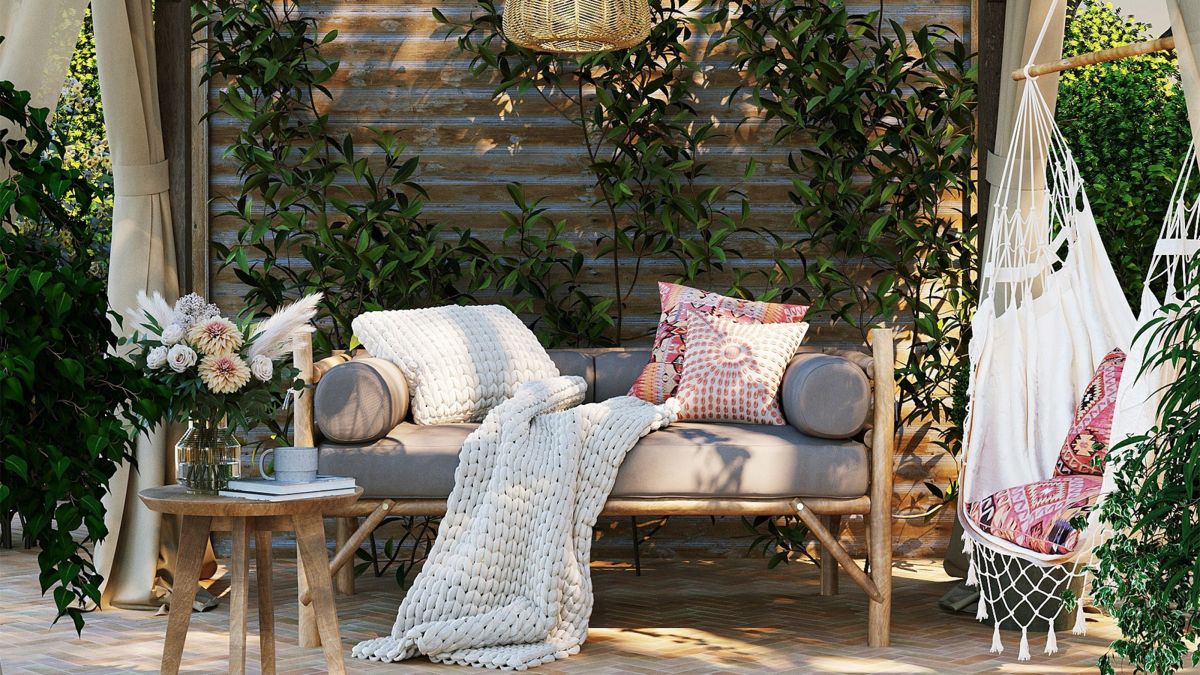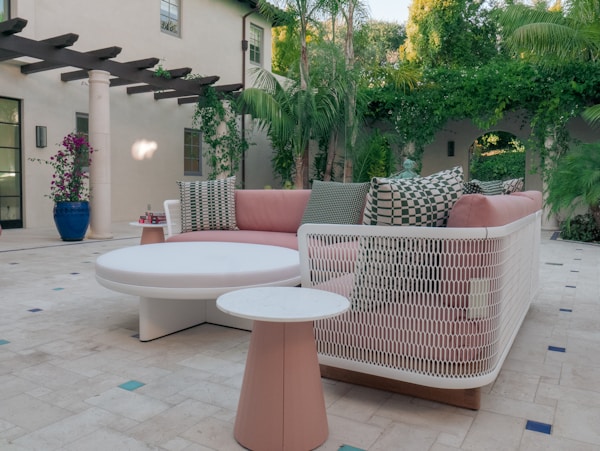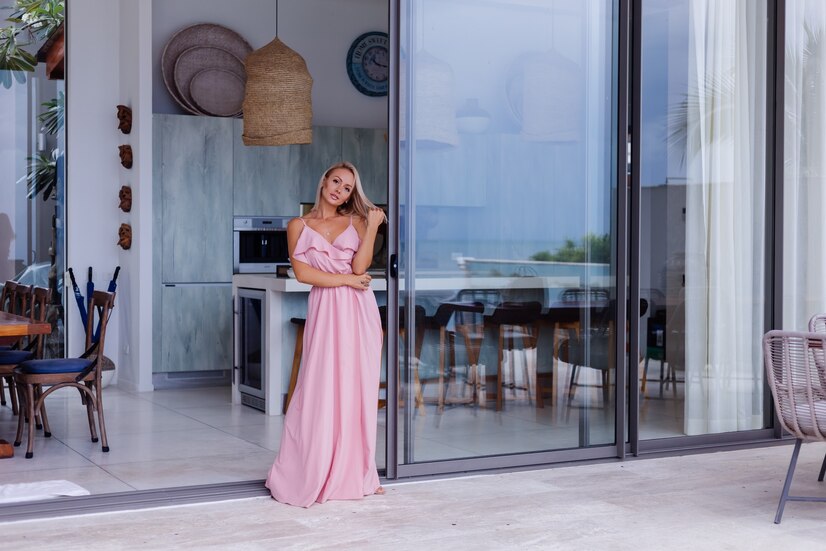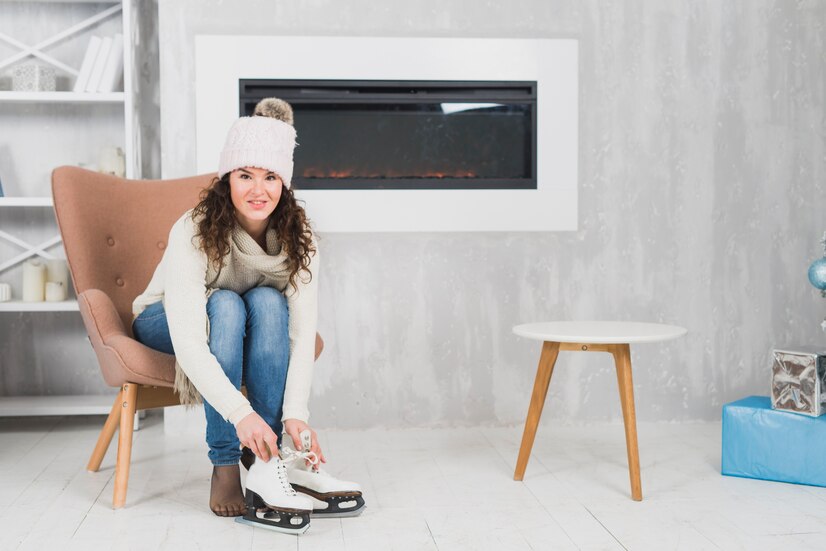Home Improvement
Essential Pieces To Furnish Your New Patio

When it comes to investing in your home, creating a beautiful patio can be a wise decision. Not only does it increase the value of your home, but it also provides an outdoor area for relaxation. Having a patio is a great way to enjoy the outdoors while still having the convenience of being in the comfort of your own home. Whether you want to host a family gathering or just enjoy some peace and quiet, having a patio is the perfect way to do it. However, you need to buy the right furniture and decor to maximize the value of your investment. If you’re in need of advice or inspiration, keep reading to learn about some essential pieces to furnish your new patio.
What are some essential pieces to furnish your new patio?

An outdoor hanging chair is a fantastic piece of furniture for any patio. Hanging chairs can be an ideal addition to your outdoor space, adding visual interest and providing a comfortable place to relax and spend time with family or friends. This type of chair has been around since the 19th century when it was popularized by Victorian-era gardeners who hung them from trees in their gardens. Today, there are many styles of outdoor hanging chairs available that range from simple metal frames with fabric cushions to intricately designed wicker swings.
Adding portable lighting solutions to a new patio is an upgrade that can drastically improve the overall aesthetic of the area. Portable lights come in a variety of shapes, sizes, and styles; they are available as both solar-powered and electric-powered units. For entertaining spaces, you can opt for string lights or lanterns, which can be hung from trees or pergolas to create an ambient atmosphere for gatherings with friends or family. You could also install LED floodlights that provide bright illumination for any nighttime activities like barbecues.
No matter whether you’re aiming for a modern or traditional aesthetic, incorporating stylish accessories and decorations is a must. These pieces are what really bring the space together and give it personality. From outdoor rugs to planters and artwork, there’s no shortage of decor to choose from when you’re looking for ways to add style and character to your patio.
How else can you improve your home’s exterior?

Now that you know how to furnish your patio, let’s discuss some other things you can do to improve your home’s outdoor space. For example, landscaping is a smart investment for homeowners. Landscaping adds aesthetic appeal to your home and it can increase the property value as well. Landscaping isn’t just about increasing the value of your home though – it’s also about making your home more comfortable and enjoyable to live in. You can be as creative as you want, but make a plan before you start so you can stay organized.
Repainting the exterior of your home is an effective project that can provide a dramatic change without breaking the bank. While repainting the outside of your home can be a big job, it doesn’t have to be daunting. With a little bit of planning, you can easily transform your home’s exterior with a new coat of paint. Take your time so you can choose a color that matches the atmosphere you want to create and your existing architecture. If you don’t have painting experience, it’s always best to hire a professional to handle the job.
As you can see, furnishing your new patio with the right pieces of furniture and decor is an integral part of creating an outdoor living space that is both aesthetically pleasing and functional. By selecting the right furniture, accessories, and decorations, you can create an outdoor area that will provide years of enjoyment and fun for you and the other members of your household. Some other ways to improve your property’s outdoor space include investing in landscaping or repainting your home’s exterior. If you follow the advice in this article, then you can design the patio of your dreams.
Home Improvement
Enhancing Home Comfort with Residential Screen Doors: Benefits and Selection Tips

The Significance of Screen Doors in Home Design
The role of screen doors extends well beyond mere aesthetics or keeping unwanted bugs at bay. Serving as the intermediary between private indoor spaces and the breath of the outdoors, they encapsulate the core principle of harmonizing indoor comfort with nature’s charm. When one opts for including residential screen doors, the benefits are manifold, encompassing improved air circulation, increased exposure to natural light, and an often-overlooked psychological uplift. Homeowners increasingly recognize the intrinsic value of a well-designed screen door, enhancing their abode’s visual appeal and fostering a healthier environment conducive to well-being.
Types of Residential Screen Doors
In an era of vast choices, selecting the correct type of screen door is an exercise in reflecting one’s personal style and lifestyle needs. The market offers traditional hinged screen doors, revered for their classic appeal, and the convenience of sliding doors, which are space-saving and ideal for limited areas or patios. Those looking for a blend of innovation and practicality might gravitate toward retractable screen doors that offer the advantage of invisibility when not in use. Magnetic screen doors represent a modern twist, providing hands-free passage and automatic closure. Materials range from durable metals to natural woods, each offering unique textural and visual outcomes. Features such as build quality, ease of operation, and durability are crucial in determining the appropriate selection, ensuring a product that meets the functional requirements and resonates aesthetically.
Environmental and Health Advantages of Installing a Screen Door
Installing a screen door by commercial door operators offers palpable benefits that go hand in hand with environmental stewardship and personal health. By promoting the cross-ventilation of fresh air, homeowners can substantially reduce their reliance on mechanical cooling systems, thereby diminishing energy consumption and contributing to a healthier environment. This natural flow of air helps mitigate the accumulation of indoor airborne contaminants, which can be particularly beneficial for individuals with allergies or respiratory issues. Moreover, including screen doors as a passive cooling strategy can be a testament to responsible homeowner practices that align with a broader commitment to sustainable living while simultaneously curbing energy costs and fostering an atmosphere of openness and connectivity with the outdoor environment.
Security Measures and Screen Doors
While the openness of screen doors is among their greatest assets, it does not necessitate a compromise in home security. Advances in design have seen the emergence of screen door models that integrate robust materials and enhanced locking mechanisms, thereby acting as a formidable deterrent to intrusions. Manufacturers have been attentive to consumer demand for products that marry the allure of open-door living with peace of mind, developing screen doors that are resilient to forced entry and capable of withstanding harsh weather conditions without faltering.
Customizing Screen Doors to Your Home Aesthetics
A screen door is more than just a functional add-on. Still, it can also be a statement of style that harmonizes with the home’s existing architectural nuances or introduces an eclectic visual element. The customization process is a journey through many choices in color, patterns, and finishing materials, where the desired outcome is both an aesthetic delight and a testament to durability. The texture of the screen material offers a playground of tactile and visual variance, potentially becoming a subtle centerpiece that complements modern and traditional design palettes.
Maintenance and Care for Screen Doors
Like any other feature of the home’s exterior, screen doors demand attention and care to ensure they remain in prime condition. Routinely inspecting and cleaning the mesh to prevent dust build-up and addressing any tears or damages immediately can prevent minor issues from escalating. Hinges and locks should be checked periodically for functionality, and it is prudent to apply lubricants to maintain smooth operation. Proactive maintenance extends the screen door’s lifespan and ensures it performs its duties effectively.
Installation Considerations for Screen Doors
Installation is a pivotal aspect that can dictate a screen door’s smooth functioning and longevity. Homeowners are faced with the decision of tackling the task independently or enlisting the skills of professionals. DIY enthusiasts may find this a rewarding project, but it’s essential to gauge one’s proficiency and the complexity of the installation process before diving in. Ensuring the right fit and alignment can be the difference between a screen door that operates flawlessly and one that becomes a persistent nuisance.
Cost-Benefit Analysis: Investing in a Quality Screen Door
While the upfront expense of a superior screen door might be notable, its value proposition extends far beyond the initial investment. Quality screen doors heighten the home’s aesthetical appeal and contribute to tangible energy savings over time. The additional layer of security and reduced need for air conditioning that a well-chosen screen door brings to the table embodies a prudent investment that can translate into considerable savings and increased property value.
Technological Advancements in Screen Door Manufacturing
Today’s manufacturing landscape for screen doors speaks to a narrative of innovation and continuous improvement. Materials engineered for ultimate durability and mesh designs are at the forefront, allowing maximum airflow while being nearly invisible. Smart home integrations are also a growing trend, with capabilities such as remote locking systems and sensors that align with modern, tech-savvy lifestyles.
Conclusion: The Future of Residential Screen Doors
Looking to the horizon, screen doors are set to evolve alongside the currents of sustainable design and smart home technology. The quest for greener, more energy-efficient homes will likely drive further refinements in materials and construction. In contrast, the proliferation of connected home ecosystems could usher in a new wave of intelligent screen doors that amplify convenience and security.
They are investigating how screen doors complement energy-efficient home strategies. The U.S. Department of Energy offers guidance on energy-saving door selections. For additional insights into better home ventilation and screen doors’ role, peruse the thoughtful exploration by Inhabitat.
Home Improvement
Maximizing Home Comfort and Efficiency with Innovative Floor Vent Designs

The Role of Floor Vents in Modern Home Design
The significance of air distribution within a home must be considered. It plays a pivotal role in ensuring that the environment remains comfortable and the air remains fresh. Homeowners can masterfully control their living space’s climate with the proper floor vents. Today’s floor vents offer more than just functionality—they come in various innovative designs that can complement the modern home’s aesthetics, enabling them to blend into the overall home design or enhance it. Add to that the potential for improved energy efficiency, and you have a component that can make a significant difference in a living space’s overall comfort and functionality.
Understanding Different Types of Floor Vents
From brass to hardwood floor vents and everything in between, the range of materials available for floor vents is broader than ever. The choice of material affects not only the durability and longevity of the vents but can also play a significant role in shaping the feel of a home. Beyond the material, the design of the vent is equally essential, influencing the flow of air and the interior’s visual appeal. Whether the requirement is for a standard vent that blends into the background or a decorative piece that serves as an accent, the variety of options ensures a perfect choice for every homeowner. Proper attention to size and placement can assist in optimizing airflow and enhancing energy efficiency, making the selection of the floor vent an essential consideration in modern home design.
Advancements in Floor Vent Technology
In recent years, significant advancements have been made in the HVAC field, including innovations in floor vent designs. Modern vents are now equipped with features that not only promote better air circulation but also aim to enhance indoor air quality. For instance, some advanced models boast integrated sensors that adjust airflow automatically depending on the room’s temperature, as highlighted in an article from Home Comfort News. Innovative vents are particularly noteworthy as they communicate with other home automation systems to create an optimally heated or cooled environment. These technological strides are about comfort and achieving greater energy efficiency, which is crucial in today’s eco-conscious world.
The Science of Airflow: How Floor Vents Affect Home Climate
The principles of thermodynamics and fluid mechanics govern the function of floor vents in a home. The fundamental design of a vent can significantly impact how air is distributed throughout the space. For instance, vents positioned too close to one another may cause short-circuiting of air, leading to inefficient heating or cooling. Moreover, the right vent design can help mitigate common issues such as drafts, heat stratification, or excellent air pooling in lower areas. Understanding these airflow dynamics is essential when laying out a plan for vent placement in a home, making it crucial for designers and homeowners to pay careful attention to this aspect of HVAC system design.
Aesthetic Considerations for Floor Vents in Home Decor
Regardless of whether the intent is for the vents to stand out or blend in, a variety of aesthetic approaches can be taken. For a covert appearance, selecting vent materials that match the surrounding flooring can render them almost invisible to the casual observer. Alternatively, those looking to make a bold statement can opt for vents in contrasting materials or intricate patterns that add a touch of elegance to the space. By harmonizing functionality with aesthetic appeal, floor vents can be hidden and complementary to thoughtful interior design, enhancing the home’s overall ambiance and character.
Energy Efficiency and Sustainability in Vent Design
Energy efficiency is not only a matter of cost savings; it’s increasingly seen as a moral imperative in the face of environmental challenges. Selecting floor vents that contribute to a home’s overall energy efficiency can significantly impact both utility bills and ecological footprint. Modern floor vent design has embraced eco-friendly materials and manufacturing processes to minimize environmental impact without sacrificing performance or aesthetic quality. Design innovations strive to optimize airflow, thereby reducing the load on HVAC systems and, consequently, the energy required to maintain comfortable living conditions. A feature article from Sustainable Home News delves into the importance of sustainable design in modern homes, emphasizing how the right choices in vent design can align with these values.
Installation and Maintenance Best Practices
The initial installation of floor vents plays a crucial role in determining their performance and efficiency. An improperly installed vent can lead to leakage and inefficiencies in the HVAC system. That’s why it is often recommended that vents are installed by professionals who can ensure a snug fit and proper integration within the floor. Beyond installation, regular maintenance of floor vents is essential. Maintenance includes periodic cleaning to prevent the build-up of dust and particulates that could impede airflow and an inspection to ensure that the vents continue to operate effectively. Proactive maintenance not only prolongs the life of the vents but also enhances their performance over time.
The Future of Floor Vents: Trends and Innovations
Like many other home features, floor vents are subject to evolving trends and consumer demands. The growing trend of smart home technology, for example, is influencing the development of vents that can be controlled remotely via smartphones or integrated with other smart devices. Additionally, there’s an increased emphasis on design that aligns with modern interior aesthetics without compromising efficiency. Future innovations in vent design will likely continue to balance these considerations, offering homeowners solutions that are environmentally friendly, energy-efficient, and visually appealing.
Considering Health and Allergy Factors
Indoor air quality has become a significant health concern, especially for allergies and asthma patients. The right design and installation of floor vents can significantly reduce dust mites, pollen, and other allergens distributed through a home’s HVAC system. Features such as vent filters can trap these particles before they spread, maintaining a healthier living environment. Homeowners must consider these health factors when selecting floor vents, as the correct choice can contribute to the overall wellness of the occupants.
Decision Factors: Choosing the Right Floor Vents for Your Home
The decision to choose the suitable floor vents for a home is multifaceted. Homeowners must weigh factors such as compatibility with their HVAC system, design preferences, budget constraints, and potential environmental impact. It’s essential to also think about the long-term aspects, like the durability of materials and how maintenance requirements will suit the homeowner’s lifestyle. In the quest to achieve optimal functionality and an attractive home environment, evaluating these considerations will yield a choice that serves both immediate needs and long-term satisfaction.
Home Improvement
How to Maintain Your Residential Heating System for Optimal Performance

Why Maintenance is Crucial
Regular heating system maintenance is vital to ensure it operates efficiently and safely. Routine residential heating repair can help you avoid unexpected breakdowns that might leave you in the cold during the winter months. Moreover, according to the U.S. Department of Energy, consistent upkeep can prevent small problems from becoming significant issues, extend the lifespan of your heating system, and reduce overall energy costs. Neglecting maintenance could lead to higher energy consumption, increased utility bills, and possibly even dangerous situations if leaks or other safety concerns go unnoticed.
Common Maintenance Tasks
Maintaining your heating system may seem daunting, but it can be manageable with a few straightforward tasks. Simple things like replacing filters, checking for leaks, and cleaning air ducts can significantly affect system performance and indoor air quality.
- Filter Replacement: Filters should be swapped out every 1-3 months. Dirty filters restrict airflow, forcing your system to work harder and less efficiently, ultimately increasing energy bills.
- Leak Checks: Inspect ducts and pipes regularly for any potential leaks. Leaking ducts can cause heated air to escape into unused spaces, resulting in wasted energy and uneven heating in your home.
- Cleaning Ducts: Regularly clean air ducts to remove dust, debris, and allergens. Clean ducts ensure that the warm air circulating in your home is clean and healthy, improving indoor air quality.
Implementing these tasks as part of your routine can lead to a more efficient and effective heating system, ensuring you and your family stay warm and cosy throughout the colder months.
Seasonal Checklist
Each season brings different challenges for your heating system. Following a seasonal checklist can help you stay ahead of any issues and ensure your system runs smoothly year-round:
- Summer: Test your system to ensure it’s ready for use come winter. Running the system during the summer can help identify any issues that must be addressed before the cold weather arrives.
- Fall: Schedule a professional inspection. An expert can identify and fix potential problems before the heating season starts. Use resources like this fall maintenance checklist to help guide your preparations.
- Winter: Monitor the system regularly for performance issues. Pay attention to unusual noises or irregular heating patterns, and address problems promptly to avoid more significant issues.
- Spring: Once the heating season ends, shut down the system and clean it thoroughly. This step helps ensure the system is in good condition when you need it again next winter.
By following a seasonal checklist, you can keep your heating system operating at peak efficiency, ensuring a comfortable living environment all year round.
Signs Your System Needs Repair
Recognizing when your heating system requires professional repair can save you from costly replacements and ensure your home stays warm. Here are some common signs that indicate your system may need professional attention:
- Unusual Noises: Any grinding, banging, or squealing sounds from your heating system could indicate a mechanical issue that needs to be addressed.
- Inconsistent Temperatures: If some rooms are warmer or colder than others, it may signal problems with the ductwork or the heating unit itself.
- Higher than Average Energy Bills: If you notice a sudden spike in your energy bills without a corresponding increase in usage, your system might be operating inefficiently due to underlying problems.
Addressing these signs promptly can prevent serious issues and ensure your heating system runs efficiently and effectively.
Energy Efficiency Tips
Improving the energy efficiency of your heating system not only saves money but also benefits the environment. Here are some tips to help you enhance your system’s efficiency:
- Use a Programmable Thermostat: This device allows you to set different temperatures for different times of the day, reducing energy usage when you’re not home or sleeping.
- Ensure Your Home is Well-Insulated: Proper insulation helps keep the warm air inside your home, reducing the need for your heating system to work harder.
- Seal Any Gaps or Cracks: To prevent heat loss, check for and seal any gaps or cracks around doors and windows. Drafty areas can significantly impact your home’s overall energy efficiency.
These tips can help you reduce energy consumption, lower utility bills, and maintain a comfortable home environment.
When to Call Professionals
While DIY maintenance can handle many tasks, certain issues should be left to professionals. For example, it’s time to call experts if you notice persistent issues such as strange noises, inconsistent heating, or higher energy bills despite regular maintenance. A professional technician has the skills and equipment to diagnose and repair complex problems safely.
Regular professional inspections can also identify potential issues before they become serious, saving you time and money in the long run. Trusting professionals ensures the problem is diagnosed correctly and repaired safely, maintaining your heating system’s efficiency and longevity.
-

 Health2 weeks ago
Health2 weeks agoHealthcare management consulting: Navigating the complexities of an evolving sector
-

 Home Improvement2 weeks ago
Home Improvement2 weeks agoHow to Maintain Your Residential Heating System for Optimal Performance
-

 Home Improvement2 weeks ago
Home Improvement2 weeks agoMaximizing Home Comfort and Efficiency with Innovative Floor Vent Designs
-

 Home Improvement1 week ago
Home Improvement1 week agoEnhancing Home Comfort with Residential Screen Doors: Benefits and Selection Tips
-

 Health1 week ago
Health1 week ago6 Ways Cupping Therapy is Enhancing Wellness in Geneva
-

 General1 day ago
General1 day agoAre Electric Cars or Gasoline Cars Cheaper?
